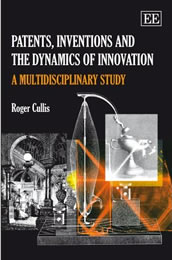BOOK REVIEW
PATENTS, INVENTIONS AND THE DYNAMICS OF INNOVATION
A MULTIDISCIPLINARY STUDY
By Roger Cullis
Cheltenham, UK and Northampton, MA, USA: Edward Elgar Publishing, 2007, 333 pp, £75.00, ISBN 978-1-84542-958-4

Download options |
 |
|
DOI: 10.2966/scrip.050208.438 |
||
How does an invention arise? What are the mechanisms involved in the innovation process?
In this book, Roger Cullis deals with these questions and others, providing a comprehensive and detailed analysis of the socio-economic factors that influence innovations. This book is unlike any other texts currently available as it offers a unique practical and multidisciplinary study on how inventions have occurred over the past two hundred years, affecting the growth of the economy. As the author writes, in the increasingly globalised economy we are currently living in, a multidisciplinary approach is needed in order to assess the dynamics of innovation. To this end, case studies are conducted in the fields of electronics, electrical and communication engineering industries.
The book is divided into fifteen comprehensive and logically organised parts.
Chapter one and two set the scene and describe the methodology used for the study. Subsequently, in chapter three, the author questions how an invention arises. This represents a “core” section, as it identifies the various stimuli that can potentially affect the innovation process. The stimuli that contribute to the success of an invention are considered to be hierarchical factors and can be summarised as follow:
- Random events/ chance (euphorically called by the author “serendipity”);
- Personality & motivation of the author;
- Intellectual property rights;
- Market structure;
- Communications;
- External agencies (i.e. government policy, regulatory control, economic cycles);
- Finance.
The innovation factors are then contextually examined in chapter four. A case-study is conducted in order to determine the stimuli’s individual influence on the creation of innovation. As inventions are by definition not uniform due to their different interaction with the external environment, the study begins by classifying inventions into different categories in relation to the mechanics involved in their conception (chapter five). This analysis leads to the conclusion that innovation is a socio-deterministic process, the success of which highly depends on timing, existence of an economic advantage, physical feasibility and commitment from the inventor (chapter six). Furthermore, this shows how inventions have formed the foundation for the global economy.
From the case studies analysis, the characteristics of the individual factors of inventions are then drawn up in chapters seven to eleven. The use of many practical examples together with the methodical analysis exposed succeed in shedding light over the often highly complex dynamics involved with the technological innovation process.
Finally, chapter twelve and thirteen put forward a “black box” model of the process of innovation that highlights how the stimuli interact within each other both from a qualitative and quantitative perspective. The model is of particular interest as it enhances the general understanding of the innovation process, allowing predictability of its future course. This is done by applying established mathematical methods to both the individual innovation components and the relationships between them.
The book concludes with a very useful prologue summarising and highlighting the core issues discussed and the bias that might have possibly affected the study.
Overall, the author should be congratulated. He has provided a highly valuable contribution to the deep understanding of the dynamics of innovation, one of the most relevant topics of our global economy. From these assumptions, Patents, Inventions and the Dynamics of Innovation will be of great interest and will serve as an important point of reference for a variety of audiences, spanning from inventors themselves to patent attorneys, IP practitioners, academics and innovation economists.
Rosa Maria Ballardini
Researcher, HANKEN-Swedish School of Economics and Business Administration
& INNOCENT Graduate School- IPR University Center
© Rosa Maria Ballardini 2008

This work is licenced under a
Creative Commons Licence.
Please click on the link to read the
terms and conditions.
